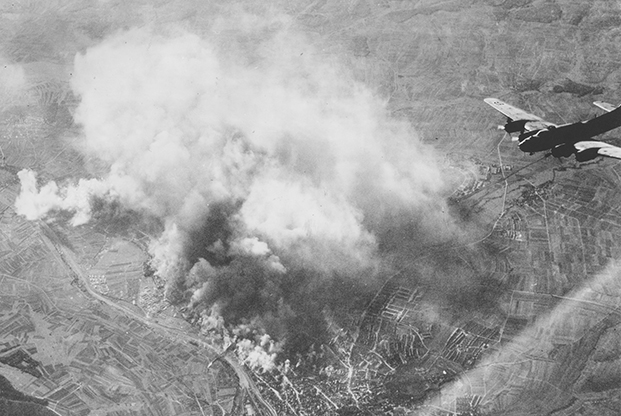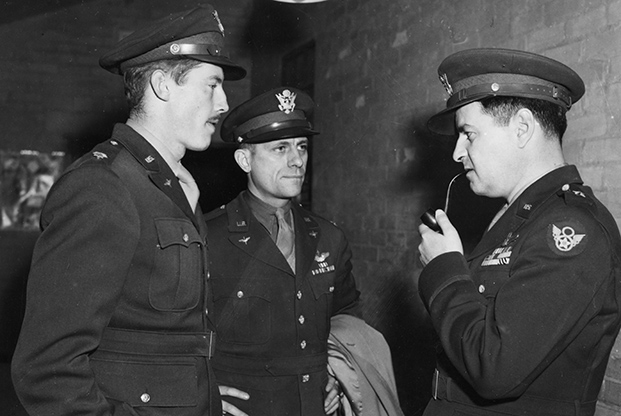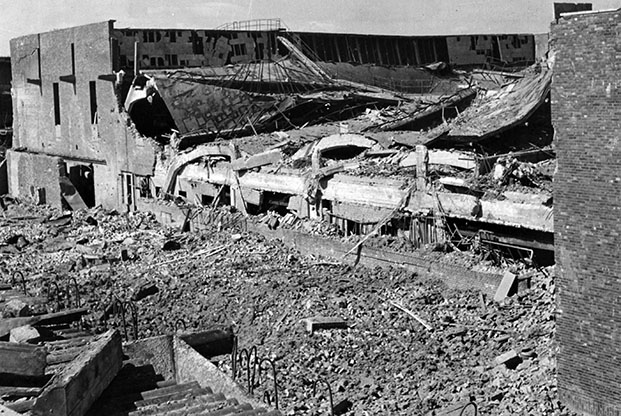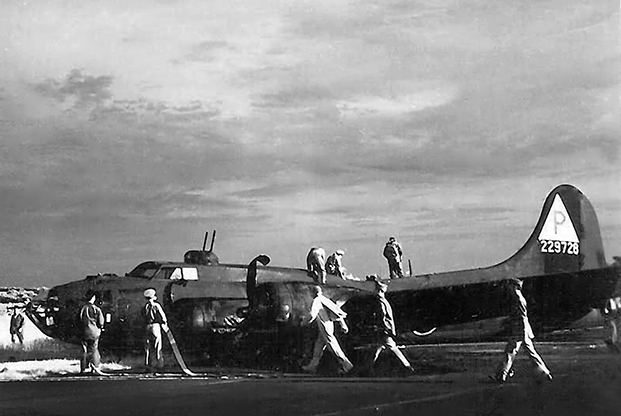
Eighth Air Force destroyed some 75 percent of Schweinfurt’s ball-bearing production and severely damaged industrial, railroad, and urban areas. Photo: USAAF/AFA
Many know of the initial Eighth Air Force raid on Schweinfurt, Germany’s, ball-bearing factories. Fewer are aware of the second strike, on Oct. 14, 1943.
To its survivors, the mission came to be known as “Black Thursday.”
Even before World War II began, the US Army Air Corps had created a target list for a potential strategic bombing campaign in Europe, should one be needed. Besides obvious objectives such as transport netorks, aircraft factories and petroleum, a prime potential choke point seemed to be Germany’s sophisticated ball-bearing production.
The “anti-friction” industry was vital to nearly every wartime product including aircraft, vehicles, and instruments. For example, a typical aircraft engine used more than 1,000 bearings; an 88 mm flak gun had 47; and a 200 cm searchlight needed 90.
In 1941, Britain’s Ministry of Economic Warfare identified ball bearings as a vital component of the Reich’s manufacturing industry. Schweinfurt, an industrial city in Southeastern Germany, accounted for more than 40 percent of the nation’s ball-bearing production; nearly three times the next-biggest producer, Stuttgart.
Schweinfurt was one of only two cities below 100,000 in population among the joint command’s top thirty targets; the other being Bitterfeld’s chemical plants.
The Casablanca Conference in January 1943 formalized allied bombing strategy, with major goals of destroying or interdicting Germany’s military, industrial, and economic systems; undermining enemy morale; and destroying Luftwaffe aircraft production. The ball-bearing industry was specifically designated “a complementary target.”
In 1943 the Army Air Forces (renamed from the Air Corps in June 1941) was committed to the prewar doctrine of daylight precision bombardment. “Precision” was a relative term, despite the vaunted “pickle barrel” accuracy of the Norden bombsight. In truth, the AAF was delighted if half the ordnance struck within 1,000 feet of the aimpoint—a goal seldom achieved. When Col. Curtis LeMay took his B-17 group to Britain in 1942, he found that no more than 20 percent of bombs struck within five miles of the target.
The lack of adequate fighter escort didn’t help. In the prewar era, Air Corps doctrine focused on bomber self-defense, since there were no fighters with enough range to escort the bombers. This led to the heavily armed B-17 Flying Fortress. A few years earlier, British Prime Minister Stanley Baldwin intoned, “The bomber will always get through.”
The Anglo-American Combined Bomber Offensive, formulated in May 1943, put more emphasis on single-point failures like ball bearings. That set the stage for two epic missions against Schweinfurt’s four biggest plants.
SCHWEINFURT I AND II
The first Schweinfurt mission had been complex, ambitious, and nearly disastrous. On Aug. 17, 1943—the anniversary of the first US bombing mission over Germany—Eighth Air Force launched a dual strike against Schweinfurt and Regensburg, with two task forces intending to split defenses 110 miles apart.
Bad weather kept the Schweinfurt-dedicated bombers of the pincer from getting off the ground in time, but the Regensburg groups launched on time.
The plan called for a landing in Tunisia.
Of the 376 bombers launched, the “Mighty Eighth” lost 60, and 50 more—though they made it back—were severely damaged; some beyond repair. The 16 percent loss rate was four times what the AAF could sustain, with 564 fliers killed or captured.
The Luftwaffe lost only 51 planes defending both targets, claiming 52 bombers and five Allied fighters—an uncommonly accurate assessment.
Two months later the Mighty Eighth tried again.
“Schweinfurt II” was a maximum effort but many groups were hard-pressed to make their quota. Some were still recovering from recent strain and attrition.
The 95th Bomb Group at Horham near the English Channel had logged a rough one, four days previously over Munster, leaving just 18 aircraft operational. That wasn’t unusual: the Eighth had lost nearly 90 bombers in three previous missions. One group’s flight surgeon confided, “morale is the lowest that has yet been observed.”
Nonetheless, the aerial “second front” against Germany proceeded apace. Eighth Bomber Command at High Wycombe, northwest of London, planned to put 360 B-17s and 60 B-24 Liberators over Schweinfurt for a second go, but that was wildly optimistic.
The command’s operations officer, Brig. Gen. Orvil A. Anderson, issued a statement for crew briefings: “This air operation today is the most important … yet conducted in this war. The target must be destroyed. It is of vital importance to the enemy. Your friends and comrades that have been lost and that will be lost today are depending on you. Their sacrifice must not be in vain. Good luck, good shooting, and good bombing.”
Though understrength, Mission 115 launched sixteen bomb groups totaling 291 Flying Fortresses against Schweinfurt, more than 450 miles from the English coast. Approximately 20 B-24s also participated in the primary mission.
At Polebrook, the 351st BG’s schedule was typical. Crews boarded their planes at 9:10 a.m. and started engines an hour later. After 10 minutes to warm up the Wright Cyclones, squadrons began taxiing at 10:20 a.m. with the lead element lifting off 15 minutes later.
The survivors returned at 5:07 p.m.—an eight-hour work day characterized by galling fear, lethal danger, numbing cold, and enduring courage.
The 1st and 3rd Air Divisions flew parallel tracks southeast from the English coast with the 1st about 20 miles to the north. Col. Budd J. Peaslee led the 1st Division, flying as a copilot with the 92nd BG.
Meanwhile, the 2nd Division sent 21 Liberators over the North Seas feinting toward Emden; the intended diversion proved unsuccessful.

Brig. Gen. Curtis LeMay (r), commander of Eighth Air Force, speaks with Col. Frederick Castle and Lt. Col. Elliott Vandevanter after the second Schweinfurt raid in 1943. Photo: American Air Museum
FEET DRY
Four miles high, typically the B-17s approached German airspace at an airspeed of about 220 mph. P-47 Thunderbolts and British Spitfires escorted them as far as possible, but it was nowhere near far enough.
The Luftwaffe response was massive. Nearly every fighter unit in Western Europe—seven fighter divisions—came up to meet the bombers. There were nine single-engine fighter wings, two twin-engine fighter wings, six night fighter wings, and two bomb wings. Additionally, at least four fighter training wings also launched sorties.
The P-47s hung in until they neared Aachen, when low fuel forced them to turn back. The 56th and 353rd Fighter Groups kept their rendezvous with the “big friends” and claimed 13 kills, but the 4th Group was foiled by weather.
From bases near the Dutch border, Jagdgeschwader 3 intercepted the bombers as they crossed the Belgian coast, giving up seven Bf 109s for a P-47 and two other Thunderbolts wrecked. Top score with a double was the 353rd Group’s Capt. Walter Beckham, destined for 18 victories, a POW camp, and a physics doctorate.
At the time, no P-38 groups were operational, so the P-47 “Jugs” left the big planes on their own still an hour from bombs away.
Over the Netherlands, the battle intensified as elements of two Luftwaffe wings slammed into the task force. The 305th Group was shot out of the sky, as Focke-Wulf Fw 190s of JG.1 and JG.26 hacked down 13 of Chelveston’s 15 B-17s.
Bomber crews reported the en route weather as “awful.” Of the 351st Group’s 18 bombers, 10 took off and bombed, while eight were weather aborts. Six returned to base and three landed elsewhere.
The 3rd Division doglegged straight south just east of the Belgian border for 60 miles, then turned hard left over Luxembourg for a straight 180-mile run to Schewinfurt. The dodge was largely successful, as the 3rd escaped heavy fighter attention until well into German airspace.
Flak was “spotty, meager, and inaccurate” during the ingress, becoming “moderate and fairly accurate at the target,” one crew reported.
The 303rd Group was typical, launching 20 aircraft from Molesworth, Cambridgeshire, with two aborts. Gunners expended nearly 100,000 rounds of .50 caliber to claim 24 interceptors downed.
Mission 115 turned into a running firefight lasting three hours, fifteen minutes. The defenders lofted 882 fighter sorties with 675 attacking US formations. Germany’s practiced radar controllers vectored three-quarters of their airborne interceptors onto the bomber stream.
As LeMay noted, all too frequently the fighter “escorts” bore black crosses on their wings. A 100th BG flier said, “No need to consider aircraft identification of those little spiteful creatures because they all meant us harm.” The single-engine fighters were persistent and aggressive. Many attacked the bombers head-on, some slow-rolling in their gunnery passes, stopping inverted for a last burst before departing in a split-S. Though some bomber men considered the tactic merely showboating, it made good sense: the fighters maintained positive G in their breakaway, exiting on the same course as the bombers so they could make another try.
The 41st Wing crews counted some 300 fighter passes in 90 minutes of sustained action. Germans mostly attacked from astern; one report noting “rocket guns were experienced.”

The Kugelfischer plant in Schweinfurt, Germany, after being destroyed by American bombers in the devastating raid. Photo: USAAF/AFA
ENTER THE B-17G
Until then, the B-17 F model had been dominant. It was produced in greater numbers than all previous versions combined (3,400 from Boeing, Douglas, and Vega, versus 650 previously). That October, the B-17G was brand-new in theater, distinct with its chin-mounted two-gun turret controlled by the bombardier. It was a belated response to the Luftwaffe’s head-on tactic that avoided the Flying Forts’ heaviest firepower—to the sides and rear. At least one G model from the 305th fell near Cologne.
While 109s and 190s often attacked from ahead, the twin-engine Zerstorer (“destroyers”) settled astern. Gauging the range carefully, Me 110s lobbed 55 mm rockets into the US formations from 500 to 600 meters, connecting occasionally.
On his fourth mission, a 384th Group navigator, Lt. Carl Abele said, “The fighters were unrelenting; it was simply murder.”
Each B-17 carried about 7,500 rounds of machine gun ammunition, and some crews fired nearly every .50-caliber round on board. Nevertheless, the Jagdwaffe pressed through streams of armor-piercing incendiaries to get at the Viermots.
Feldwebel (Sergeant) Wolfgang Brunner, an Fw 190 pilot, reported intercepting the Americans near Koblenz, 120 miles west of Schweinfurt:“One Boeing B-17 shot from formation from 7,200 meters at [1:55 p.m].“At [1:47 p.m.] we sighted two escorted US heavy bomber Verbande (groups) flying southeast at 7,200-7,500 meters. Because of the escort we were compelled to drop our tanks, but that of my Rottenfuhrer (flight leader) would not drop away. After a brief delay he ordered me to attack alone. As a result, I closed upon three Fw 190s flying at the same height as the first enemy pulk (bunch) and with them attacked the first pulk of the Verbande flying on the right, which comprised five Boeings flying alone in close formation. The attacks were carried out from the left and right sides. I attacked the last of these from the left side to an angle of 30 degrees from behind. I saw hits in the fuselage and tail and saw the vertical tail break up.
“After I pulled away, I saw the Boeing sheer away from the pulk and drop below. I had to depart, owing to low ammunition and fuel. Final destruction was obtained by JG.26.”
Of the 291 bombers dispatched, 37 had aborted, leaving 254 crossing the coast into occupied Europe. En route attrition reduced effective sorties to 222 bombers striking their briefed targets.
Visibility improved near the target, allowing navigators to confirm their approaches and bombardiers to spot their aimpoints. The two bomber tracks merged over Schweinfurt for an 18-minute aerial deluge between 2:39 p.m. to 2:57 p.m. In the 303rd BG, bombing from 24,000 feet, each B-17 dropped three half-ton general-purpose bombs and five incendiaries on the V.K.F Ball Bearing Plant.
Then the bombers exited to the south for the return, intending to coast out near Boulogne.

The B-17 El Rauncho crash-landed in England on return from the first Schweinfurt raid on Aug. 17, 1943. Photo: American Air Museum
STRUGGLING HOME
However, the Americans got little respite on the egress as some German fighter groups flew far from their bases in the Netherlands and northern Germany. 1st Gruppe of Jagdgeschwader 2 flew 180 miles to the 3rd Division’s outbound track.
Generalleutnant Adolf Galland, commanding Germany’s day fighters, wrote, “We were able to break up several bomber formations and to destroy them almost completely. The approach and return routes were marked by the wreckage of shot-down aircraft.”
Some of the fallen Flying Forts had strayed far afield. A 305th BG bomber, Lazy Baby, landed wheels up in Switzerland. Far in the opposite direction, another Chelveston aircraft was shot down near Hamburg, apparently trying to make it to Sweden.
Even nearly home, losses continued. Almost out of fuel, the 303rd BG crew of the battle-damaged Cat-O-Nine Tails bailed out over England. All fliers landed within four miles of the crash, in a Risley resident’s backyard.
Paper Doll of the 96th Group, three months old, returned with a dead pilot and badly wounded copilot. The navigator was Lt. Miles McFann, a prewar private pilot who got her down at an RAF field. He recalled, “We could have bailed out, instead of risking a crash-landing. I suppose a lot of fellows wouldn’t want to take a chance on having a navigator act as pilot, but they weren’t sticking because of their confidence in me. They all knew that [Lt. Robert] Bolick was dead inside that ship, and none of us was going to bail out and leave him in there. We just wouldn’t do it.”
Some 2,900 airmen flew the mission, of whom 648 were listed killed, wounded, or missing in action; a staggering 18 percent casualty rate.The 1st Division took the heaviest losses by far: as noted, the 305th BG wrote off 13 bombers while the 306th lost 12. In contrast, the entire 3rd Division lost 15.
Eighth Bomber Command listed 60 Flying Forts missing, plus five that crashed in England, with seven written off as “Category E,” or damaged beyond repair. All told, a horrific total loss of 72 bombers. Of the remainder, about three-quarters bore battle damage.
Aircrew gunnery claims were typically extravagant; understandable with multiple B-17s often engaging the same fighters. The original figure was an unrealistic 288, reduced to 186 “confirmed” fighters downed.
In fact, the Luftwaffe lost 53 aircraft with 29 aircrew killed or missing and 20 wounded.
AFTERMATH
The cold comfort for the severe losses was that the B-17s apparently inflicted severe damage on Schweinfurt. In some of the best bombing yet seen over Europe, 1st Division’s 91st Group scored the most hits on the target.
The 351st’s lead bombardier, Capt. Harvey D. Wallace, put all his own ordnance inside the desired 1,000-foot circle around the aimpoint. But the Eighth’s youngest bomb group, the 390th, showed the veterans how it was done: their aircraft placed 51 percent of their bombs inside the 1,000-foot circle. It was all the more impressive because the lead aircraft’s autopilot had gone haywire, forcing the crew to target manually.
The AAF intelligence assessment was favorable, predicting a 25 percent reduction in ball bearings over the next three months. However, subsequent analysis was less optimistic, noting the heaviest concentration of bombs hit between the buildings, though rail lines were impaired.
Albert Speer, Germany’s production genius, was quick to react. Despite downed phone lines, he spoke with a plant manager who reported that, beyond blast damage, the oil baths ignited serious fires. Schweinfurt’s ball-bearing production plummeted to 23 percent of the previous figure.
But Speer and his minions had options. They increased imports, especially from Sweden and shifted to slide bearings where possible. From 1937 through to 1942, Sweden provided an average 57 percent of Germany’s bearings (subsequent years lack full data). Sweden also sold bearings to Britain.
The Germans braced for the seemingly inevitable third blow, but it did not come.
Speer recalled, “The enemy—to our astonishment—once again ceased his attacks on the ball-bearing industry. … The Allies threw away success when it was already in their hands. Had they continued the attacks with the same energy, we would quickly have been at our last gasp.”
Both Schweinfurt missions had long-term effects on Eighth Air Force operations and morale. The Fall of 1943 was a grim period, when statistically it seemed impossible to complete a combat tour: four percent attrition over 25 missions was considered acceptable. After Schweinfurt II, the Eighth rolled back its deep-penetration missions for awhile, but help was close at hand: The first long-legged P-51 Mustang groups went operational starting in December.
The Mighty Eighth did return to Schewinfurt, but only five times between February and October 1944. The RAF followed up the February mission with a night strike that caused little lasting damage.
By the time ball-bearing production became a problem for Nazi Germany in late 1944, it was too late to matter: Allied bombing of oil and transport systems proved more effective in crippling the Third Reich’s industry.
Barrett Tillman is an award-winning historian who has written 50 books, including Forgotten Fifteenth: The Daring Airmen Who Crippled Hitler’s War Machine. His most recent article for Air Force Magazine was “Hard Targets,” in the February 2015 issue.